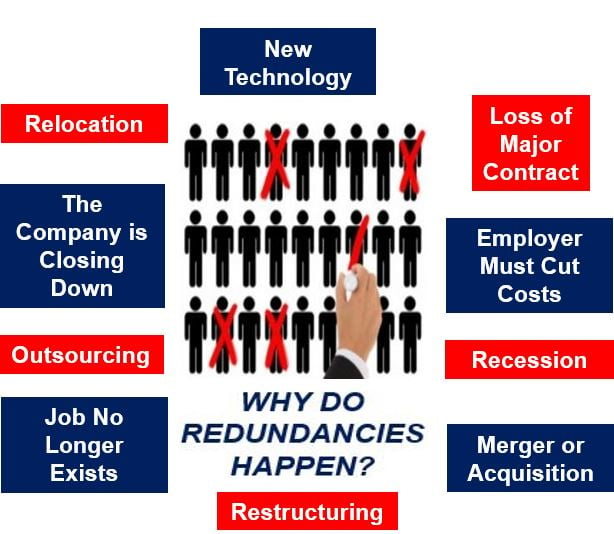Who Pays Redundancy Money? Understanding Company Duties in the UK
Who Pays Redundancy Money? Understanding Company Duties in the UK
Blog Article
Discovering the Operational Characteristics of Firm Redundancy and Its Long-Term Sustainability

Redundancy Approaches for Organization Continuity
In order to guarantee nonstop procedures, services need to apply reliable redundancy approaches for business continuity. Redundancy in this context describes the replication of critical parts or features within a system to alleviate the impact of prospective failures. By integrating redundancy techniques, organizations can boost their durability versus disturbances triggered by numerous elements such as natural calamities, devices failings, or cyber-attacks.
One usual redundancy method is the application of backup systems and information storage space services. This entails producing duplicates of vital data and systems that can be turned on in instance of a main system failure. Furthermore, companies can develop repetitive communication channels and source of power to maintain connectivity and procedures during unpredicted events.
Additionally, cross-training workers to carry out several duties within the company can work as an important redundancy approach. If crucial personnel are not available due to health problem or various other reasons, this makes sure that crucial tasks can still be lugged out also. Overall, efficient redundancy strategies are essential for companies to copyright functional connection and reduce the influence of possible disturbances.
Impact of Redundancy on Business Resilience
Provided the critical duty redundancy methods play in making sure business continuity, checking out the influence of redundancy on organizational durability comes to be necessary for recognizing the all natural functional dynamics of a business. Business durability describes an entity's capacity to adjust to disruptions, recoup from setbacks, and transform when needed while keeping core functions. Redundancy, when tactically applied, can dramatically add to enhancing an organization's resilience when faced with unforeseen challenges. By having backup systems, workers, or processes in position, companies can much better stand up to shocks and continue operations with marginal interruption.
In addition, redundancy can bolster staff member spirits and confidence, knowing that there are backup plans in location to address unexpected scenarios. This complacency can lead to raised performance and a more positive workplace. Additionally, redundancy can foster technology and creative thinking within a company as workers really feel empowered to take calculated dangers, knowing that there is a safety and security web to support them in case of failure. On the whole, the effect of redundancy on organizational resilience is profound, forming the long-lasting sustainability and success of a company.
Stabilizing Efficiency and Adaptability in Redundancy
Accomplishing a harmonious balance between operational performance and flexible flexibility is a critical challenge in the tactical deployment of redundancy within companies. Reliable procedures are necessary for keeping efficiency and cost-effectiveness, guaranteeing that sources are utilized ideally. Nevertheless, excessive emphasis on performance alone can bring about rigidity, making it difficult for organizations to adjust to unanticipated adjustments or obstacles. On the various other hand, flexibility enables organizations to react nimbly to evolving situations, promoting innovation and durability. Yet, too much flexibility without a strong operational foundation can lead to inadequacies and inconsistency.
To stabilize performance and versatility in redundancy planning, companies need to thoroughly evaluate their operational needs, market characteristics, and calculated objectives. Implementing lean techniques can image source improve performance by enhancing processes and removing waste, while cultivating a society of adaptability and constant renovation can increase flexibility. In addition, buying cross-training programs and durable communication networks can help grow a flexible labor force efficient in handling varied tasks throughout periods of shift. Inevitably, locating the appropriate equilibrium between performance and versatility is essential for constructing a sustainable and resistant organization when faced with uncertainty.
Long-Term Sustainability With Redundancy Planning
To ensure enduring practicality and security, companies have to strategically align their redundancy planning with long-term sustainability goals, thus balancing functional performance with adaptive flexibility. Business need to view redundancy not as a reactive option to instant troubles yet as an aggressive strategy for lasting success.

Positive Actions for Sustainable Business Procedures
How can companies proactively enhance their functional sustainability for lasting success? Implementing aggressive actions is essential for companies intending to make certain lasting operations.
Furthermore, cultivating a society of constant enhancement and knowing within the organization can boost flexibility to altering market conditions and customer needs. Motivating employee participation in decision-making procedures and offering opportunities for specialist advancement can increase spirits, efficiency, and overall efficiency. Developing clear goals, monitoring crucial performance indications, and regularly see this website reviewing development are vital parts of positive sustainability management.
Working together with vendors, customers, and various other stakeholders to promote sustainable practices throughout the supply chain can develop a causal sequence of positive influence - redundancy pay if company goes bust. By taking aggressive steps in the direction of operational sustainability, business can develop durability, drive advancement, and protect their lasting success in an ever-evolving business landscape
Final Thought

In the realm of business management, the critical implementation of business redundancy stands as a crucial yet complex technique that requires a fragile equilibrium in between operational performance and long-term feasibility. By exploring the functional characteristics that underpin firm redundancy and assessing its more comprehensive implications for business strength and versatility, a nuanced understanding of exactly how redundancy approaches can shape the future trajectory of a business starts to unravel.Offered the important duty redundancy approaches play in making certain business continuity, exploring the impact of redundancy on business resilience ends up being vital for comprehending the all natural functional dynamics of a firm. Generally, the effect of redundancy on organizational durability is extensive, forming the long-lasting sustainability and success of a business.
In final thought, recognizing the functional dynamics of company redundancy is essential for ensuring long-lasting sustainability.
Report this page